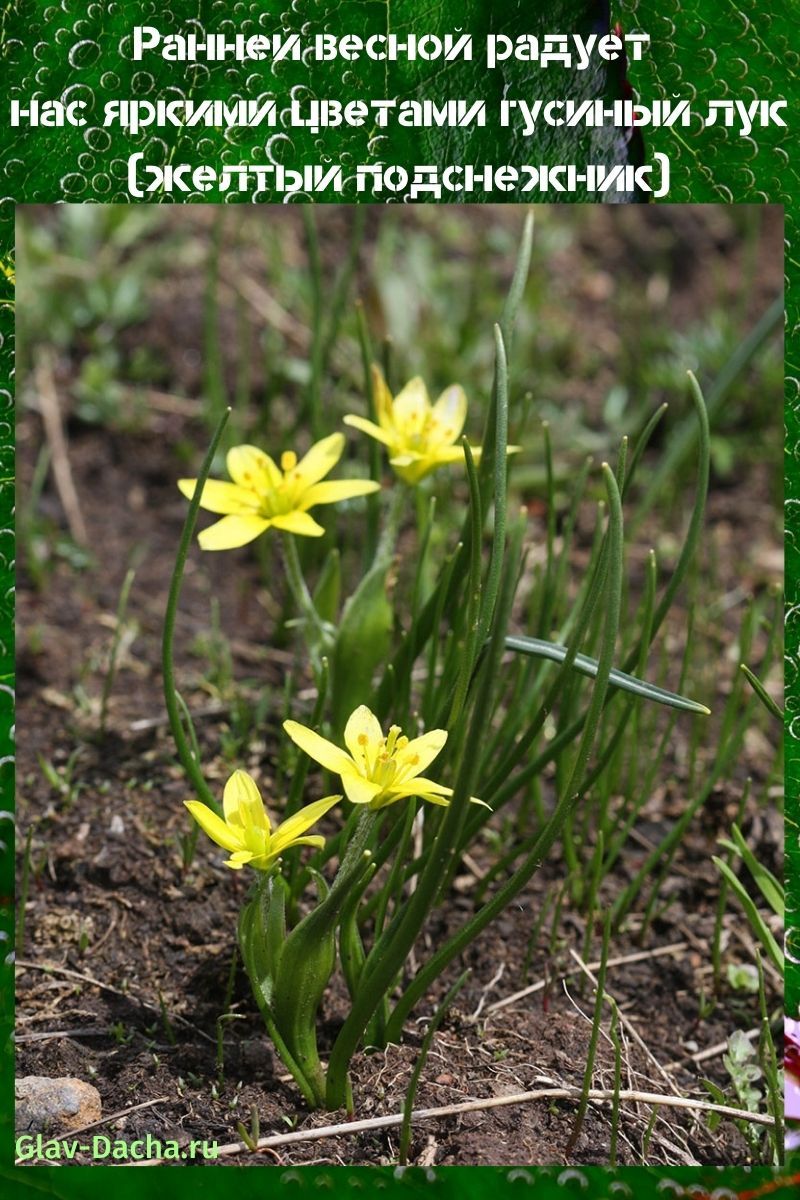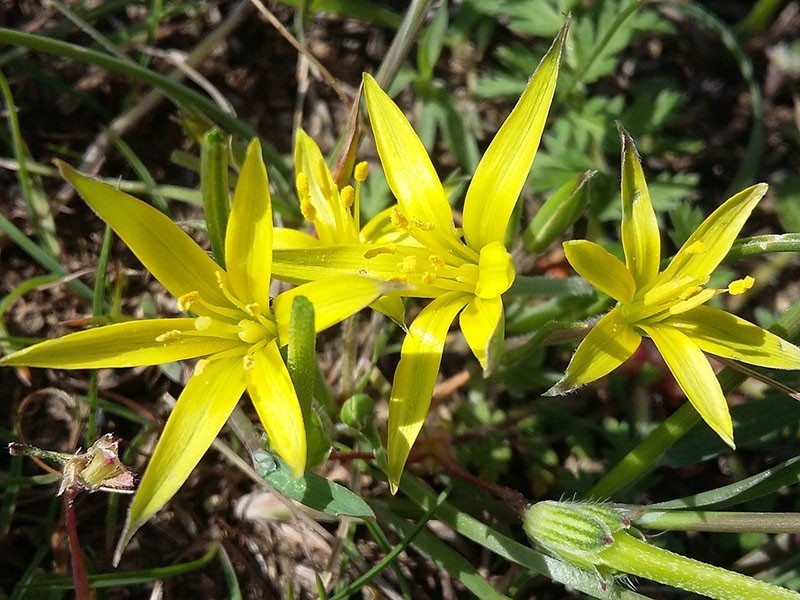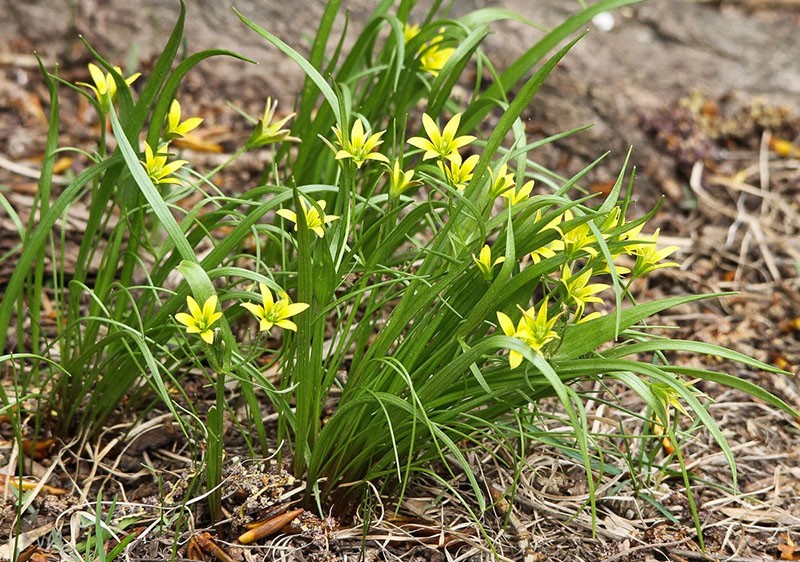In early spring, a goose bow (yellow snowdrop) pleases us with bright flowers
 A goose, goose or yellow snowdrop is a primrose that is one of the first to break out from under the snow with the onset of spring. Fragrant greens have long attracted wild geese flying from southern countries, which completely ate the stems, foliage and inflorescences of the plant. That is why it got its unusual name. Thanks to its pretty golden buds, it is popularly known as the "yellow snowdrop".
A goose, goose or yellow snowdrop is a primrose that is one of the first to break out from under the snow with the onset of spring. Fragrant greens have long attracted wild geese flying from southern countries, which completely ate the stems, foliage and inflorescences of the plant. That is why it got its unusual name. Thanks to its pretty golden buds, it is popularly known as the "yellow snowdrop".
Goose onions - plant features

Due to its unpretentiousness, the cute snowdrop adapts perfectly to any soil. The Latin name for the plant is Gagea, so many growers call it Gagea.
Description of the goose onion plant:
- The goose bulb has an oblong-oval shape, it is covered with grayish-brown scales. Every year it produces a large number of new, strong shoots that can be used to propagate the plant.

- Depending on the species, plant growth can reach 8-33 cm.
- The rooster has no more than two basal leaves of a linear shape. Stem leaves are narrowed, sharp, saturated green.
- Umbrella inflorescences, consist of 3-9 petals, flowers are formed identically to tulips.
- The petals are bright yellow on the inside and greenish on the outside.
- In sunny weather, the inflorescences of goose onions open. In the absence of sunlight, the buds remain closed.
The phase of active development of the aerial part of the goose onion begins in mid-March. The plant is excellent honey plant and is well pollinated by bees.
After flowering is complete, fruits are formed - small boxes with seeds. This happens most often in early May.
 Duration of seed ripening is up to 12 months. They have a rich, oily aroma that attracts insects to them. In this way, the ants carry the seeds of the yellow snowdrop around the neighborhood.
Duration of seed ripening is up to 12 months. They have a rich, oily aroma that attracts insects to them. In this way, the ants carry the seeds of the yellow snowdrop around the neighborhood.
Types of goose onions
 In nature, there are about 200 species of goose onions, which differ in the number and structural features of the bulbs. The aboveground part of all varieties of yellow snowdrop is almost the same.
In nature, there are about 200 species of goose onions, which differ in the number and structural features of the bulbs. The aboveground part of all varieties of yellow snowdrop is almost the same.
The most common types of goose onions are:
- small;

- yellow;

- reddish or ruddy;

- bulbous.

In the regions of the Arctic Circle, a Nenets variety of yellow snowdrop grows. This species is distinguished by the presence of two bulbs at once - a small one, about 1-2 mm in size and a large one, reaching 3-5 mm in diameter.
In the territories of Mongolia, Kazakhstan, China, coniferous forests of Siberia, you can find a granular type of goose. It has flowering stems about 18-20 cm long, bright yellow inflorescences and a brown bulb.
Many types of goose onions are in the Red Book - the reddish species is included in the Book of the Leningrad, Vologda, Kirov, Novgorod and Arkhangelsk regions, as well as the Republic of Karelia. Wild varieties of reddish, Nenets and granular goose onions are also included in the Red Book as rare and endangered species.
 Under natural conditions, the yellow snowdrop grows in Eurasia and North Africa.Among the main regions where goose onions grow are Siberia, the Far East, the countries of the Caucasus and Central Asia.
Under natural conditions, the yellow snowdrop grows in Eurasia and North Africa.Among the main regions where goose onions grow are Siberia, the Far East, the countries of the Caucasus and Central Asia.
Yellow goose bow
 The yellow goose variety is a perennial bulbous crop grown as an ornamental and medicinal plant.
The yellow goose variety is a perennial bulbous crop grown as an ornamental and medicinal plant.
Features of the view:
- perennial can reach 10-25 cm in height;
- the stem is dense, thick;
- large egg-shaped bulb with gray-brown scales;
- the plant has one flat basal leaf of a broadly linear shape, up to 4-9 mm wide;
- two sub-flowering leaves - lower lanceolate, much wider than upper;
- on erect pedicels there are 3-16 yellow flowers, with a slight greenish tint on the inside.
The inflorescences of yellow goose onions bloom in mid-April, after which round boxes with seeds are formed in late May or early June.
Small goose bow
 Lesser goose onions are a short perennial plant. It has two bulbs - a large, egg-shaped and small, rounded. The bulbs are united by a common shell, a stem grows between them.
Lesser goose onions are a short perennial plant. It has two bulbs - a large, egg-shaped and small, rounded. The bulbs are united by a common shell, a stem grows between them.
The height of the small goose onion reaches 8-16 cm. Its inflorescences consist of 3-7 flowers with linear bracts. The plant has one root leaf up to 4 mm wide. Depending on the growing conditions, the flowering of the yellow snowdrop can last from March to May. After its completion, oval capsules with seeds are formed.
Reddish or ruddy goose onions
 Reddish goose onions, also called ruddy, can be found almost everywhere - on forest edges, near roadsides, in grass meadows and fields.
Reddish goose onions, also called ruddy, can be found almost everywhere - on forest edges, near roadsides, in grass meadows and fields.
The plant reaches 13-15 cm in height, has a three-edged stem with two upper narrow-linear, sub-flowering leaves. This variety has one small onion. Its inflorescences consist of 3-18 flowers with reddish bracts.
The flowering period of the reddish goose onion is from mid-April to May. In the first half of June, spherical fruits are formed.
Growing requirements
 Goose onions, whether cultivated or wild, depends on the variety. A small species of yellow snowdrop is grown by gardeners as a cultivated ornamental plant. It is used in landscape design - to decorate flower beds and flower beds, forming original lawns with bright yellow inflorescences.
Goose onions, whether cultivated or wild, depends on the variety. A small species of yellow snowdrop is grown by gardeners as a cultivated ornamental plant. It is used in landscape design - to decorate flower beds and flower beds, forming original lawns with bright yellow inflorescences.
For growing goose onions, it is advisable to choose well-lit areas with permeable sandy-clay soils, rich in nitrogen and potassium. The yellow snowdrop has a fairly high resistance to winter frosts and sudden temperature changes, so it is necessary before winter mulch.
Goose onions are propagated by bulbs or babies growing near the underground part. They can be planted in August-September.

When growing a yellow snowdrop, you need to remember a few rules.:
- the bulbs must be separated from the mother shoot only after the foliage and stem wilt;
- the collected plant seeds must be dried in a cool, dark and well-ventilated area;
- you can start planting bulbs in August or early September;
- bulb heads must be deepened into the soil by 3-4 cm, leaving a distance of at least 12-15 cm between the plants;
- the planted bulbs germinate only after 2 years, while the yellow snowdrop blooms not earlier than 5 years after planting.
Yellow snowdrop is unpretentious to care for. The plant needs watering only during severe drought; too frequent and abundant moisture can lead to rotting of its root system.
Goose onions are a beautiful and interesting plant, many varieties of which are considered endangered and are listed in the Red Book. It is grown as a medicinal and ornamental plant that adorns the garden with sunny yellow flowers.